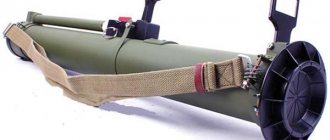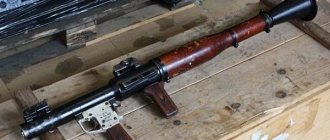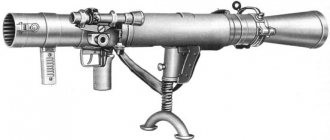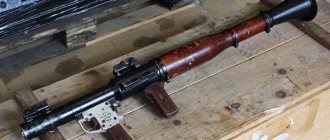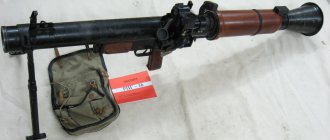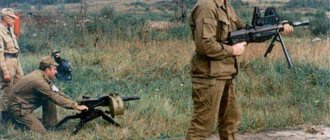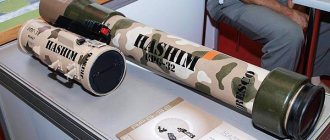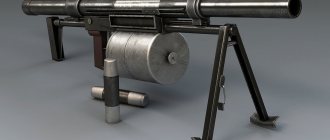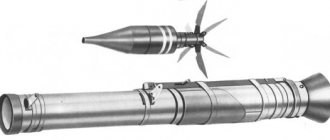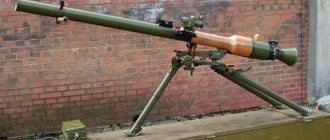Video RPG-29 Vampire
In the seventies and eighties of the last century, the Soviet defense industry created several types of rocket-propelled anti-tank grenades with different characteristics. This weapon allowed infantry to effectively fight enemy armored vehicles, but had a serious drawback. Rocket-propelled anti-tank grenades were disposable, which had a corresponding impact on their use. As for hand-held anti-tank rocket launchers, for several decades the newest system of this class in the ground forces was the RPG-7, and the Airborne Forces had the RPG-16 grenade launcher. Over time, these weapons became outdated, which is why the development of new hand-held anti-tank grenade launchers began.
RPG-29 grenade launchers, Mexican Army paratroopers, 2010
In the mid-eighties, SNPP Basalt, which was engaged in the creation of anti-tank weapons for infantry, began developing the RPG-29 Vampire project. Work on the project, named after the bat, was headed by V.S. Tokarev. As part of the new project, it was planned to create an anti-tank grenade launcher capable of hitting modern and advanced tanks of a potential enemy. The main task of the designers was to create a rocket-propelled grenade that could effectively destroy armored vehicles with dynamic protection systems. Solving this problem made it possible to significantly increase the firepower of rifle units armed with the new grenade launcher.
The RPG-29 “Vampire” grenade launcher is a launcher with sighting devices and fire control devices installed on it. In combat position, the grenade launcher has a length of 1.85 meters. For the convenience of the grenade launcher, the weapon is collapsible. In the stowed position, the Vampire grenade launcher is divided into two blocks, connected using a special coupling. In addition, for ease of carrying, the sight is removed from the grenade launcher. When disassembled, the RPG-29 grenade launcher has a length of no more than 1 meter. The total weight of the assembled weapon is 11.5 kg; after installing the 1P38 sight, the weapon becomes heavier by about 0.6 kg.
The PG-29V round (above) is unified in warhead with the PG-7VR (below)
In the middle part of the grenade launcher, on its lower surface, there is a trigger mechanism with a fire control handle and a trigger. On the upper surface of the launcher there are auxiliary sighting devices - a rear sight and a front sight. If necessary, they can be used instead of a standard sight. When disassembling the grenade launcher, the trigger mechanism and sight remain on the “front” half of the grenade launcher. On the “back” there is a folding bipod.
The standard sighting device for the RPG-29 “Vampire” grenade launcher is the 1P38 optical sight. The device with a field of view 13° wide and a magnification of 2.7x allows you to aim the weapon when firing at a distance of up to 500 meters. At the request of the customer, the Vampire hand-held anti-tank grenade launcher can be equipped with a 1PN51-2 night sight. In this case, the weapon receives the supplemented index RPG-29N. The RPG-29 grenade launcher uses the PG-29V rocket-propelled grenade as ammunition. An interesting fact is that some features of this shot had a serious impact on the appearance of the grenade launcher. For example, the large barrel length (1.85 m) is directly related to the engine used on the grenade.
Crew of the mounted RPG-29 in position. The grenade launcher is equipped with a 2Ts35 launcher.
The 105 mm caliber PG-29V rocket-propelled grenade was created taking into account the need to hit targets equipped with dynamic protection systems. For this reason, the ammunition carries a tandem cumulative warhead. The leading cumulative charge, located in the front of the grenade, should initiate an explosion of the dynamic protection unit when it hits the target. The latter spends its energy on destroying the cumulative jet of the leading charge. Thus, in front of the main charge of the warhead, the armor of the attacked vehicle remains unprotected. According to available data, the warhead of the PG-29V grenade is capable of penetrating more than 600 mm of homogeneous armor covered with dynamic protection.
The tail of the grenade has a jet engine. An interesting feature of the PG-29V ammunition, which distinguishes it from other rounds for domestically developed hand-held anti-tank systems, is the absence of a propellant charge. To accelerate the grenade to the required speed, only a jet engine is used. The solid fuel charge is ignited using an electrical system: the grenade launcher trigger and the ammunition igniter are connected through a contact ring in the tail of the grenade.
The project provides for the manufacture of the engine from fiberglass or steel. The material of the engine housing directly affects the characteristics of the grenade: ammunition with a fiberglass part leaves the barrel at a speed of up to 255 m/s, with a steel part – up to 230 m/s. In flight, the grenade is stabilized by rotation, for which a folding stabilizer with 8 blades is installed in its tail section. The grenade is also equipped with a tracer to monitor its flight. The charge of pyroxylin powder, which accelerates the grenade in the barrel, is designed in such a way that its combustion is completed before the ammunition exits the grenade launcher. Such measures make it possible to reduce the impact of powder gases on the shooter, simplify the design of the ammunition and grenade launcher, and also simplify aiming, since there is no active section during the flight of the PG-29V grenade.
RPG-29 with optical-electronic sight KPUO
The crew of the RPG-29 “Vampire” grenade launcher consists of two people. To carry weapons and ammunition, the crew has two packs. One of them carries a grenade launcher, the other carries 3 grenades. An experienced crew can fire at a rate of up to 4 rounds per minute. The RPG-29 Vampire anti-tank rocket launcher and the PG-29V round were put into service in 1989. However, as far as we know, mass production of this weapon has not yet begun. Because of this, even a quarter of a century after the new system was adopted, the main anti-tank rocket launcher remains the time-tested RPG-7.
In 1993, the Vampire grenade launcher was first demonstrated to the foreign public. During the first arms exhibition IDEX-1993 in Abu Dhabi (UAE), demonstration shooting took place, during which the new domestic development made a great impression on potential customers. As a conditional target for the grenade launcher at these shootings, an armor plate 300 mm thick was used, installed at an angle of 60° to the vertical and additionally covered with a dynamic protection unit. The RPG-29 grenade launcher successfully overcame the dynamic protection and pierced the armor, making a through hole in it about 600 mm deep.
Option RPG-29 with a machine tool and an optical-electronic sight KPUO, no later than 2006.
At the beginning of the 2000s, a project to modernize the RPG-29 “Vampire” grenade launcher appeared, designed to improve its characteristics. Central Design Bureau Tochpribor, which develops various electronic systems, presented the 2Ts35 grenade launcher optical-electronic sight. This device allows you to detect and identify enemy tanks at a distance of about 1000 meters and calculate the necessary corrections for shooting. The 2Ts35 sight is equipped with a laser rangefinder capable of measuring ranges within 1200 meters. The RPG-29, mounted on a machine and equipped with a 2Ts35 sight, can complement or, in certain conditions, replace anti-tank missile systems with guided munitions.
The production and supply of the RPG-29 “Vampire” grenade launcher and ammunition for it raise certain questions. As far as is known, the domestic armed forces have not received a single grenade launcher of the new model. However, there is information about the supply of these weapons to foreign countries. For example, in the middle of the last decade, the Israeli media reported that a considerable part of the Israeli armored vehicles that participated in the Second Lebanon War (2006) were damaged or destroyed using RPG-29 grenade launchers. A number of these grenade launchers were captured by Israel as trophies during the fighting.
Models of PG-29V and TBG-29V rounds
New assumptions about possible export supplies of Vampire grenade launchers appeared at the end of 2012 and beginning of 2013. The reason for them was video recordings of the combat use of grenade launchers by militants during the civil war in Syria. From this we can conclude that the Russian defense industry has produced a number of RPG-29 grenade launchers at the request of foreign countries. Judging by the conflicts in which these weapons were used, they were supplied to Iraq, Iran or Syria. There is no exact information on this matter.
The Mexican armed forces have a number of RPG-29 Vampire grenade launchers, as evidenced by photographs from military parades. At similar events several years ago, fighters were seen with Russian grenade launchers and ammunition for them. The origin of these weapons also raises questions. It is still unknown whether Mexico purchased the Russian weapons directly from the manufacturer or whether the grenade launchers were purchased from a third country, which in turn received them from Russia. Regardless of these facts, the RPG-29 Vampire anti-tank rocket launcher, although adopted by the Russian army, has not yet entered service with the troops. For some not entirely clear reasons, promising weapons were adopted only on paper, which is why fighters have to use old RPG-7 grenade launchers.
RPG-29 with optical-electronic sight PUO 2Ts35
Modifications
– RPG-29 (1989) – standard version of the RPG-29 with a 1P38 optical sight.
– RPG-29N – a variant of the RPG-29 with a 1PN51-2 night sight.
– RPG-29 easel (2003) – a version of the RPG-29 with a machine tool and an optical-electronic sight PUO 2Ts35. Not adopted by the Russian Armed Forces as of 2008.
– RPG-29 mounted (2003) – a version of the RPG-29 with a mounted mounting and an optical-electronic sight KPUO. Not adopted by the Russian Armed Forces as of 2008.
Status: USSR / Russia
– 1989 – adopted for service with the PG-29V cumulative grenade.
– 2010 – in service. Information has appeared that the RPG-29 was never produced for the Armed Forces of the USSR and Russia, although it was put into service.
RPG-29 disassembled for transportation
Export
Only one batch of RPG-29 was produced and exported, presumably to Syria or Iraq or Iran. Later, RPGs were probably also produced for export.
Mexico - 2007 - there are a number of RPG-29s in service with PG-29V rounds. Perhaps the grenade launchers were supplied from a third country. It is also possible that a batch of RPG-29 was produced specifically for Mexico. There is unconfirmed information about the production of the RPG-29 in Mexico under license.
Lebanon - in 2006, RPG-29 grenade launchers were effectively used against Israeli Merkava tanks by Hezbollah militants. Russia denied supplying weapons to the movement, but based on indirect evidence, the militants probably received the weapons from Syria.
Syria - before 2006, there may have been deliveries of RPG-29.
TTD
The RPG-29 is a compact weapon; it takes up very little space in the transport case, only a meter in length. It also weighs a little, a little over five kilograms and plus a grenade - another seven kilograms. You can shoot both at night and during the day, and in addition to destroying armored vehicles, you can also solve the problem of resistance of infantry fortifications, destroy pillboxes, bunkers and dugouts, for this there are also TBG-29V thermobaric ammunition. The effective range of aimed fire against a stationary target is half a kilometer, and against a moving one – 300 meters. The assembled length of the grenade launcher is 1 meter 85 cm.
The crew consists of two fighters, but experience in Syria (against government troops) and Iraq (against the US Army) proves that, if necessary, one person can handle it if he can carry two bags: one with launchers, the other with three grenades .
Design
The RPG-7 is a lightweight dynamo-reactive (no recoil when fired) weapon.
The grenade launcher and shot were based on the reusable recoilless launcher and shot with an over-caliber warhead, which had proven themselves in the RPG-2. The grenade launcher consists of a barrel with optical and mechanical sights, a trigger mechanism with a safety catch, and a firing mechanism.
Grenade launcher barrel
The barrel of a grenade launcher consists of a pipe and a pipe and serves to direct the flight of the grenade and remove powder gases when fired. Unlike the RPG-2, the RPG-7 grenade launcher has an extension of the barrel in its middle part - a charging chamber - to more fully utilize the energy of the propellant charge, and a bell in the breech - to ensure recoillessness of the complex.
Trigger mechanism
Trigger mechanism - used to release the hammer, strike the firing pin and engage the safety.
Sights
PGO-7V optical sight reticle 1 — sight scale, 2 — lateral correction scale, 3 — rangefinder scale
A Bulgarian soldier with an RPG-7 grenade launcher equipped with a collimator sight Mechanical sight Mechanical sight - used in case of damage (failure) of the optical sight.
The main one for the RPG-7 is the PGO-7 optical sight (or its modifications PGO-7V, PGO-7V-2, PGO-7V-3). The optical sight is designed to monitor the battlefield, determine the distance to the target, introduce corrections for the range and speed of the target, taking into account the ballistics of various ammunition, and point the grenade launcher at the target, taking into account the corrections[3].
The sight is an optical system of lenses and prisms, enclosed in a sealed metal case filled with dry nitrogen to prevent fogging. The optical sight provides a fixed apparent target magnification of 2.7 times. The sight is equipped with a set of light filters that improve visibility in difficult weather conditions. To prevent unmasking glare from the sun and contamination, the sight is equipped with a rubber cap that fits onto the lens[3].
The PGO-7V sight reticle has a developed correction scale, as well as a rangefinder scale, which allows you to quickly determine the range to a “tank” type target (2.7 m high). The handwheel provides input of aiming angles in the range of 0-51.2 artillery units, and the aiming mark on the reticle: 0-45.7. In poor lighting conditions, the sight reticle can be illuminated. The backlight lamp uses galvanic batteries A316 or 2РЦ63[3].
The sight retains its characteristics over a wide temperature range (from −50 to +50 °C), and is also able to withstand high mechanical loads.
Night optical sight
The RPG-7 grenade launcher can be equipped with first-generation night sights (such as the specialized PGN-1 grenade launcher night sight, or the NSPUM universal night sight (product 1PN58)[4]) or second-generation NSPU-3 night sights[5].
For a grenade launcher with a night sight, a light-blocking mechanism is additionally introduced, which prevents the sight from being illuminated by the flame of its own shot.
Universal sighting device
The universal sighting device is a mechanical device weighing 0.55 kg for introducing corrections into the optical sight. It has been used since 2001 in grenade launchers of the RPG-7V2 (RPG-7D3) modifications in conjunction with an optical sight. Allows you to significantly increase the target firing range of thermobaric (TBG-7V) and fragmentation (OG-7V) grenades: up to 550 and 700 meters, respectively[6].
